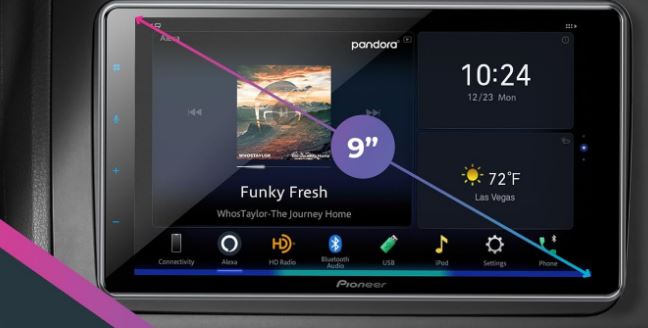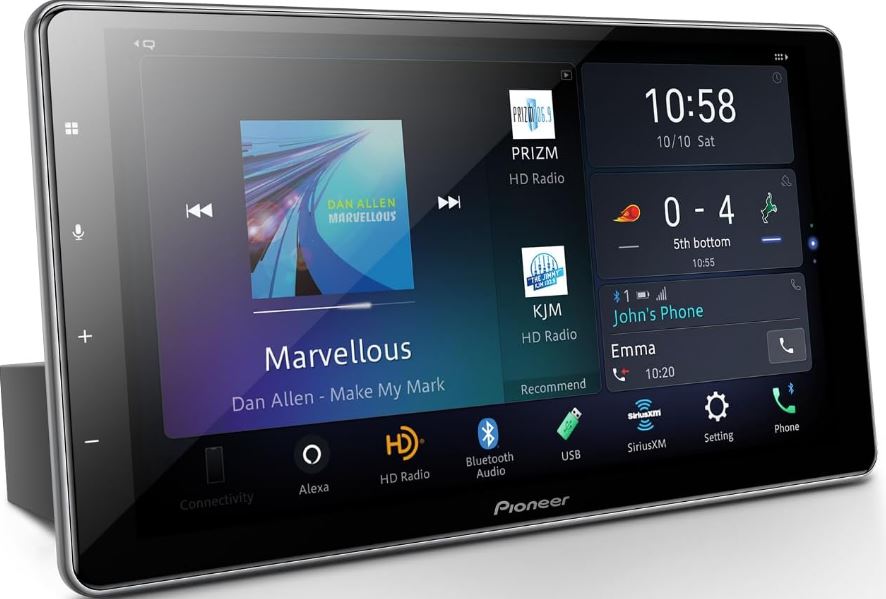
Pioneer Digital Multimedia Receiver
Pioneer LOGO
Information to user
- This device contains license-exempt transmitters)/receivers) that complies with Part 15 of FCC Rules and Innovation, Science, and Economic Development Canada license-exempt RSS(s). Operation is subject to the following two conditions: (1) this device may not cause interference, and (2) this device must accept any interference, including interference that may cause undesired operation of this device.
- The Bluetooth antenna cannot be removed (or replaced) by the user.
- This equipment complies with FCC/ISED radiation exposure limits set forth for an uncontrolled environment and meets the FCC radio frequency (RF) Exposure Guidelines and RSS-102 of the ISED radio frequency (RF) Exposure rules. This equipment should be installed and operated keeping the radiator at least 20 cm or more away from the person’s body.
- This transmitter must not be co-located or operated in conjunction with any other antenna or transmitter.
- Information to User – Alteration or modifications carried out without appropriate authorization may invalidate the user’s right to operate the equipment.
- NOTE: This equipment has been tested and found to comply with the limits for a Class B digital device, under Part 15 of the FCC Rules. These limits are designed to provide reasonable protection against harmful interference in a residential installation. This equipment generates, uses, and can radiate radio frequency energy and, if not installed and used by the instructions, may cause harmful interference to radio communications. However, there is no guarantee that interference will not occur in a particular installation. If this equipment does cause harmful interference to radio or television reception, which can be determined by turning the equipment off and on, the user is encouraged to try to correct the interference by one or more of the following measures:
- Reorient or relocate the receiving antenna.
- Increase the separation between the equipment and the receiver.
- Connect the equipment to an outlet on a circuit different from that to which the receiver is connected. Consult the dealer or an experienced radio/TV technician for help.
FEDERAL COMMUNICATIONS COMMISSION SUPPLIER’S DECLARATION OF CONFORMITY
- Product Name: RDS AV RECEIVER
- Model Number: DMH-W2770NEX, DMH-W2700NEX
- Responsible Party Name: PIONEER ELECTRONICS (USA) INC. SERVICE
- SUPPORT DIVISION
- Address: 2050 W. 190TH STREET, SUITE 100, TORRANCE, CA 90504, U.S.A.
- Phone: (800) 421-1404
- URL: http://www.pioneerelectronics.com
WARNING
- Slots and openings in the cabinet are provided for ventilation to ensure reliable operation of the product, and to protect it from overheating. To prevent fire hazards, the openings should never be blocked or covered with items (such as papers, floor mats, and clothes).
- Do not ingest the battery, Chemical Burn Hazard. The remote control supplied or sold separately with this product contains a coin/button cell battery. If the coin/button cell battery is swallowed or placed inside any part of the body, it can cause severe internal burns or other severe injuries in 2 hours or less and can lead to death.
- Keep new and used batteries away from children. If the battery compartment does not close securely, stop using the product and keep it away from children. If you think batteries might have been swallowed or placed inside any part of the body, seek immediate medical attention.
The Safety of Your Ears is in Your Hands
Get the most out of your equipment by playing it at a safe level— a level that lets the sound come through clearly without annoying blaring or distortion and, most importantly, without affecting your sensitive hearing. Sound can be deceiving. Over time, your hearing “comfort level” adapts to higher volumes of sound, so what sounds “normal” can be loud and harmful to your hearing. Guard against this by setting your equipment at a safe level BEFORE your hearing adapts.
- ESTABLISH A SAFE LEVEL:
- Set your volume control at a low setting.
- Slowly increase the sound until you can hear it comfortably and clearly, without distortion.
- Once you have established a comfortable sound level, set the dial and leave it there.
- BE SURE TO OBSERVE THE FOLLOWING GUIDELINES:
- Do not turn up the volume so high that you can’t hear what’s around you.
- Use caution or temporarily discontinue use in potentially hazardous situations.
- Do not use headphones while operating a motorized vehicle; the use of headphones may create a traffic hazard and is illegal in many areas.
Preparing the remote control (DMH-W2770NEX)
Remove the insulation sheet before use.
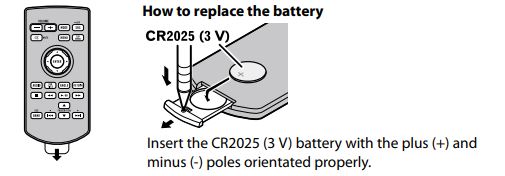
WARNING
Batteries (battery pack or batteries installed) must not be exposed to excessive heat such as sunshine, fire ortho like.
CAUTION
- Remove the battery if the remote control is not used for a month or longer.
- There is a danger of explosion if the battery is incorrectly replaced. Replace only with the same or equivalent type.
- Do not expose a battery to high or low extreme temperatures during use, storage, or transportation.
- Do not allow the battery to be exposed to fire or excessive heat or to become crushed or cut, or dispose of the battery in a fire or hot oven, which could result in an explosion.
- Do not handle the battery with metallic tools.
- Do not store the battery with metallic objects.
- If the battery leaks, wipe the remote control completely clean and install a new battery.
- When disposing of used batteries, please comply with governmental regulations or environmental public institution rules that apply in your country/area.
- “Perchlorate Material – special handling may apply. See www.dtsc.ca.gov/hazardouswaste/ perchlorate. (Applicable to California, U.S.A.)”
Meanings of symbols used in this manual

What’s What
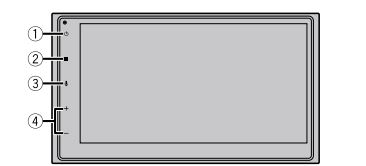
- Display off B Power off
- Display the top menu screen & Mute or unmute
- Activate the voice recognition mode & Display the mobile device search screen
- Adjust the volume
Selecting the source
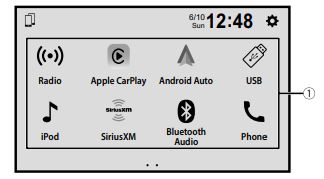
- Select a source / Display hidden sources
Tuner operation
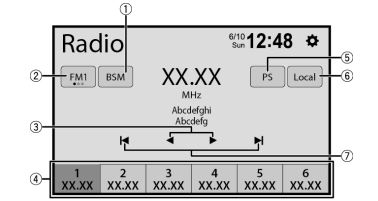
- Store the strongest broadcast frequencies
- I Select a band
- I Tune into the next station
- L Recall the preset channel stored to a key from memory & Store the current broadcast frequency to a key
- Recall a preset channel in order and broadcast each channel for 10 seconds.
- Tune into only radio stations with sufficiently strong signals
- Start to seek to turn
Moving images operation
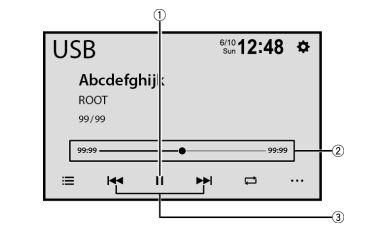
- I Pause and start the playback
- E Change the playback point
- L Selects the previous file or the next file. & Performs fast forward or fast reverse. Touch again to change the playback speed.
Bluetooth telephone operation
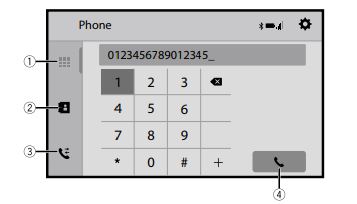
- Enter the phone number directly
- Switch to the phone book mode
- Switch to the call history list
- Make an outgoing call
FOR MORE MANUALS BY PIONEER, VISIT MANUALSDOCK
FAQS About Pioneer Digital Multimedia Receiver
What is a Pioneer digital multimedia receiver?
A Pioneer digital multimedia receiver is a car stereo system that offers various features beyond traditional audio playback, such as touchscreen displays, support for multimedia formats like CDs, DVDs, USB, and Bluetooth connectivity.
What are the key features of Pioneer digital multimedia receivers?
Key features typically include a touchscreen interface, support for various audio and video formats, Bluetooth connectivity for hands-free calling and audio streaming, compatibility with smartphone integration platforms like Apple CarPlay and Android Auto, and customizable audio settings.
What is Apple CarPlay and Android Auto compatibility?
Apple CarPlay and Android Auto are smartphone integration platforms that allow users to mirror their smartphone’s interface on the car’s display, enabling access to apps, navigation, music, and calls through voice commands or touchscreen controls.
Can Pioneer digital multimedia receivers play DVDs?
Yes, many Pioneer digital multimedia receivers come with DVD playback capabilities, allowing users to watch movies or videos on the car’s display.
Do Pioneer digital multimedia receivers support rearview cameras?
Yes, most Pioneer digital multimedia receivers support rearview camera input, enabling drivers to have a clear view of obstacles or objects behind the vehicle while reversing.
Are Pioneer digital multimedia receivers compatible with steering wheel controls?
Yes, many Pioneer digital multimedia receivers are compatible with aftermarket steering wheel control interfaces, allowing users to retain the functionality of their vehicle’s steering wheel controls while upgrading the stereo system.
Do Pioneer digital multimedia receivers have built-in navigation?
Some Pioneer digital multimedia receivers come with built-in navigation systems, while others offer navigation functionality through smartphone integration platforms like Apple CarPlay and Android Auto.
How do I connect my smartphone to a Pioneer digital multimedia receiver?
You can connect your smartphone to a Pioneer digital multimedia receiver using Bluetooth, USB cable, or through wireless smartphone integration platforms like Apple CarPlay and Android Auto.
Can Pioneer digital multimedia receivers play music from USB drives?
Yes, Pioneer digital multimedia receivers typically have USB ports that allow users to play music or videos from USB flash drives or external hard drives.
Are there different sizes available for Pioneer digital multimedia receivers?
Yes, Pioneer offers digital multimedia receivers in various sizes to fit different car models and dashboard configurations, including single-DIN and double-DIN sizes.

